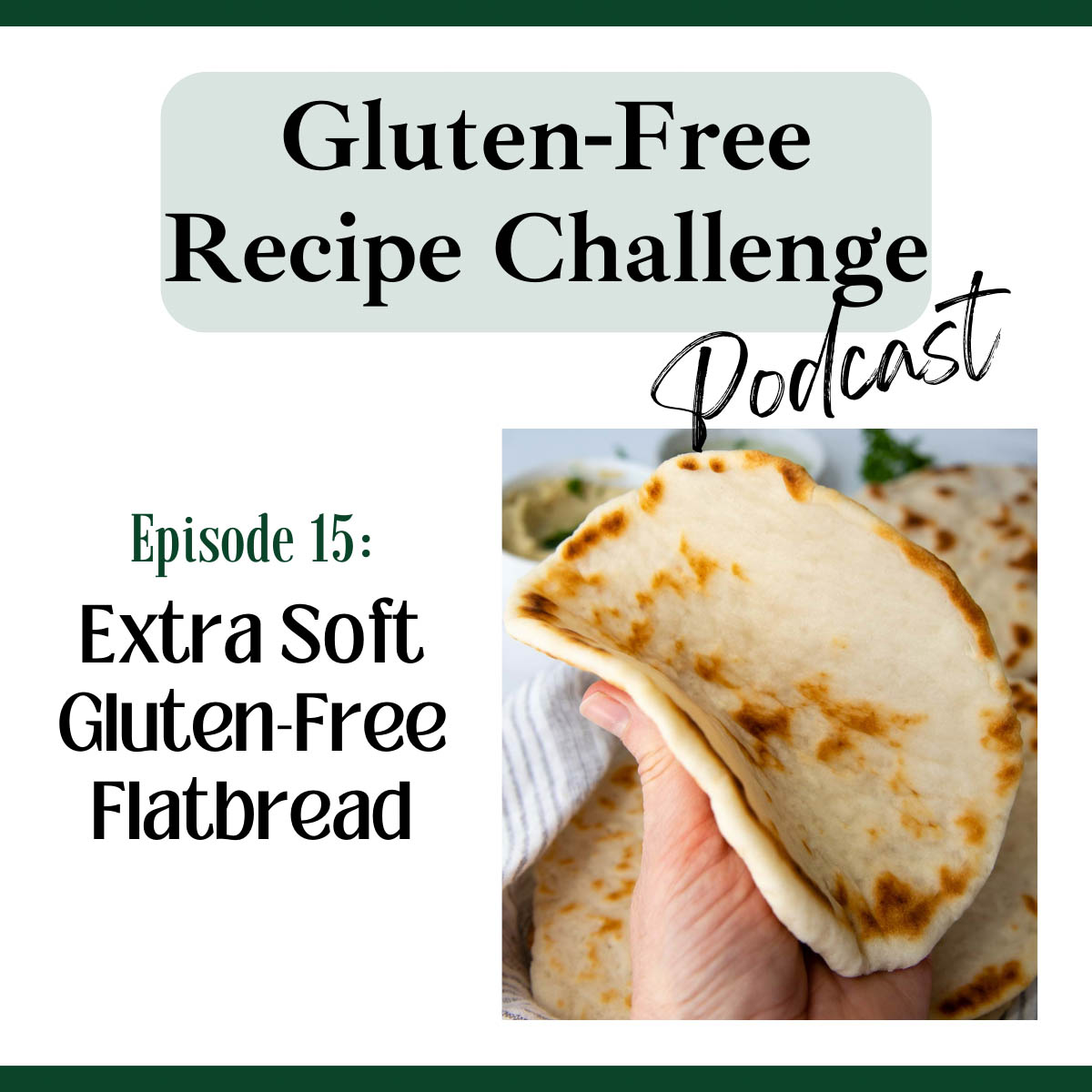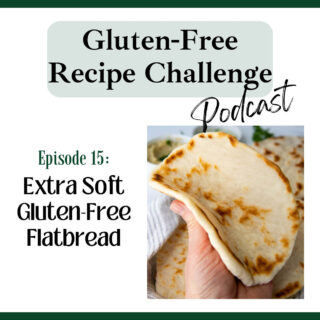In episode 15 learn how to make soft, fluffy gluten-free flatbread perfect for pizzas, dips, wraps, and more. Not only does this easy, one bowl recipe mix up in minutes, but the texture will fool anyone it’s GF, dairy-free, and vegan! Join Melissa, gluten-free cookbook author, as she shares many easy, pro tips to make this audio recipe for gluten-free pita and you won’t have to miss out anymore!

Listen to this episode, along with the full audio library, on iTunes, Spotify, Stitcher, TuneIn, or your favorite podcast player.
Recipes and Resources Mentioned
Recommended Equipment
Recommended ingredients
Follow Along
Don’t forget to subscribe to our weekly newsletter! Besides receiving an immediate GLUTEN-FREE BAKING BONUS, this weekly newsletter gives you direct access to the newest recipes, helping you with menu planning and exclusive tips!
Transcript
Hey everyone. I’m Melissa Erdelac, host of the Gluten-Free Recipe Challenge podcast and creator behind the gluten-free website, Mamagourmand. Here we take beloved recipes you thought you’d never enjoy again and transform them into easy copycat versions, just as good as the originals.
So who knew a gluten-free flatbread was going to take the internet by storm? I’ve recently shared this recipe on a gluten-free Facebook group and holy shit, people have gone a little bonkers over it. I had no idea that this was on so many people’s GF bucket list.
I actually created this recipe around Easter time because we were going to have a Mediterranean inspired menu with a lot of dips, and it’s not so fun to just eat hummus and baba ganoush with a spoon.
So I wanted to make something I wouldn’t feel left out and silently salty while everyone else was dipping in their nice, fluffy pita. Honestly, I didn’t think this recipe would gimme so much trouble. The problem wasn’t the dough or rolling it out or how to cook it. In fact, all of that came together pretty easily and it looked great after it was cooked.
The problem came with the texture. It had this little bit of chew to it that just kept throwing me off and I didn’t know how to handle it because I couldn’t add less flour because I still needed to shape and roll the dough, so I needed to do something else.
Today I will talk about how I combated this problem while still keeping the method for making it pretty quick and simple. We’ll walk through how to make them, how gluten-free flatbreads are going to change your life, and the most perfect way you can use ’em this summer, which is grilled pizzas.
Also full disclosure, I set off to make this a pita recipe, but I couldn’t get those damn pockets to form. I tried and I tried and damn it all to hell, those fucking pockets kicked my ass. Then I decided, who needs a freaking pocket? It’s fucking delicious. You fold it in half and you call it a day. So problem solved. Moving on.
First, what you’ll need for this recipe. I used my stand mixer with a paddle attachment, which made it really easy. You just throw everything in a bowl, mix it. You don’t have to get your hands dirty, but you could probably use a bowl and a wooden spoon too. The dough is gonna get pretty thick, so you’ll have to eventually knead it with your hands.
The other thing you’ll need is a non-stick skillet. Some pita recipes. See, I keep calling it pita, it’s flatbread. Some flatbread recipes they actually bake them in a really high oven. I tried this, but I feel like cooking it on a skillet is way easier to control the temperature. They only take a couple minutes on each side, and then you also get those nice brown markings on them.
And when I baked them, they just kind of were one even color. They didn’t look as pretty. So I recommend the skillet method.
As for the ingredients, the gluten-free flour I use and always recommend is Cup4Cup gluten-free flour. This gives the nicest, softest texture, but I will say none of the ingredients in this recipe have dairy in them. If you need a completely dairy-free recipe, you cannot use Cup4Cup because it has milk powder in it. Also side note this is completely vegan too. If you need a dairy-free vegan recipe, I would use King Arthur Measure-for-Measure or whatever your preferred brand is.
The other thing that you’ll need, and this was the secret ingredient to getting rid of that chew, was potato starch. I use this in other recipes where I want that nice, fluffy texture. In fact, I used it for the gluten-free hamburger buns, which I talk about in episode nine, and instead of adding additional flour to get that structure. I substitute another gluten-free starch and in this case a real light, fluffy, gluten-free starch that doesn’t weigh down the crumb, but still absorbs the liquid. And that is potato starch.
This is potato starch, not potato flour, which is a completely different thing. Potato flour is actually dehydrated potatoes, ground up. Potato starch is that sediment that drops down from potatoes when you’re soaking them in water and it’s dried and turned into a flour. It’s really affordable to buy, Bob’s Red Mill makes it, and I could find it at my local grocery store or on Amazon.
The other thing you’ll need is psyllium husk powder, which huge fan of psyllium husk powder in gluten-free baking. This is another reason why this dough is really easy to handle and why you don’t have to add a bunch of flour to it. The psyllium, which I talk about more in episode seven, absorbs the liquid in the dough, and helps mimic that elasticity in the crumb structure of wheat baked goods. This is an essential ingredient to get a good flat bread. You can also buy this on Amazon. It’s pretty cheap and I use it a lot of my gluten-free bread. So I would recommend picking up a pack.
I will link to the one that I use because some of ’em are darker than others, and if you get a dark psyllium husk powder, it kind of turns your baked goods like this weird purple color. So I found a couple that are lighter in color and I will link to that in the show notes.
The other thing you’ll need is active dry yeast. You can also use instant yeast in this recipe, and if you’re using instant yeast, then I would just add that to the dry ingredients. You don’t need to activate it with the water.
Next you’ll need baking powder. I always use a combination of yeast and baking powder with gluten-free breads because it helps add rise in loftiness and especially cuz this has such a short cook time on the stove that it really boosts leavening.
And let’s see, what else. The only other thing you need is a little bit of sugar to activate the yeast in the water and a small amount of olive oil, which I use a little bit in the dough. And then also for shaping and rolling.
Okay, so let’s make some good ass flatbreads. First, you’re going to turn on your oven to 150 degrees and warm it up to 150 degrees.
Once it reaches that temperature, you turn off the oven, leave the oven door shut, and this just serves as an extra warm place for the dough to rise.
Once your oven is shut off, then you can start making the dough. In a small bowl combined the warm water, the yeast, and the sugar, just mix it together and set it aside for five minutes to activate the yeast. When it’s ready, it’ll look like frothy on top.
Then in your stand mixer bowl, you combine the gluten-free flour, the potato starch, psyllium husk, salt, and baking powder, and just mix that on low speed. Next you add in the yeast water mixture and the oil, and you mix that on medium speed for three minutes and then that’s it, your dough’s done. At this point, the dough will be pretty stiff, and if you aren’t using a stand mixer, this is when you’ll kind of have to maybe knead it with your hands to get everything well mixed.
Use that same bowl and just scrape down the dough into the middle of the bowl, cover it with plastic wrap, and then place it in the warm oven. I leave the oven door open slightly a jar for the first, like five or 10 minutes because I don’t want it to be too warm in there where it’ll dry out the dough.
So leave the door open a little bit for a few minutes and then you could go ahead and shut it and let it rise for 45 minutes.
When you’re ready to shape the dough, pour a little bit more olive oil and a small bowl. And this is just to kind of dip your fingers in if the dough sticks. Place a large sheet of parchment paper on your workspace and then use your slightly greased fingers to divide the dough into five equal size balls. If you wanna be super precise about it, you can get out a food scale and you can measure ’em to make sure they’re, they’re all the same size or just kind of whatever, weigh ’em roughly in your hand. And make sure that they’re about the same size.
Cover those balls with plastic wrap and just let it rest on the counter for 10 minutes. Towards the end of the 10 minutes, that’s when you’ll want to heat your skillet. It’s completely dry you don’t put any oil in the skillet, and you heat it over medium heat. You wanna make sure it’s nice and hot before you start cooking it. So go ahead and heat it up before you start rolling out the dough.
Okay, so move the balls to the side, keeping ’em covered with the plastic wrap. And on the other side of the parchment, put a very, very, very light sheen of olive oil on it, just so the parchment is slightly greased. Place a ball right in the middle and just flatten it out into a thick disc. And then you’re just gonna use your rolling pin to shape it into a six and a half inch circle.
And when you roll it, roll it a couple times, rotate it a quarter turn, roll it a couple times until you get a nice round shape. If you don’t have a nice round shape, also not the end of the world, it doesn’t matter. But if you want it more round, I always kind of take some off of one end and pinch it on the other just to make it round.
The other reason why I say six and a half inch circle is because this kind of just makes it the perfect thickness for cooking. So you don’t want it bigger than this because then the dough will be too thin and then smaller, the dough will be too thick.
Then you’re just gonna take a spatula, lift up the circle and flip it onto the hot skillet. Cook undisturbed for one and a half to two minutes. You flip it over and then you cook again, one and a half to two minutes. You might think it’s done before the two minutes on the second side, but you still need to cook it that full one and a half to two minutes.
Otherwise , it won’t be enough time for the moisture to evaporate. And your flat breads will be rather dense when you bite into them and not as fluffy. Even if they look done, keep ’em in that whole time.
While your flatbread is cooking, while one flatbread is cooking, go ahead and start to roll out the next one. I roll these out as I’m cooking them.
When you’re done with the flatbread, if you’re gonna serve it right away, put them in a lint-free kitchen towel and then just cover ’em up to keep warm as you’re cooking the other ones. If you’re not going to eat these right away, then just put them on a wire rack to cool completely.
I do recommend when you serve them though, that you’ve served them a little bit warm. So if you’re letting them come to room temperature, I would microwave them. I would wrap them in a very slightly damp paper towel and microwave them for about 15 seconds just to rewarm them.
Okay, so here comes the life-changing part. How are you gonna use these flat breads? In any way that you would use a pita or naan, you could use them with dips, like hummus or anything like that. You could serve it alongside a curry, but they could also be used similar to, uh, tortillas, you could use them for wraps. You could fill ’em with chicken salad or tuna salad or lunch meat. You could put veggies in them.
I’ve also used them recently as a gluten-free pizza crust, and it turned out amazing. To use as a pizza, you would prepare them and you would cook as directed. You spread a little bit of tomato sauce on it, your cheese and your toppings.
Place it on a baking sheet or a pizza stone and just bake it in a 425 oven for 5-8 minutes or until the cheese is bubbly. And if you want the cheese to be really golden and bubbly, you could turn on the broiler for about a minute to get that nice golden color on the cheese . It’s really good.
But it’s summertime and you might not wanna turn on your damn oven. The other thing you could do is grill them. To do this, do the same thing, prepare the flat breads, cook ’em on the stove . You could technically cook the dough on the grill too, but I don’t know, it’s a grilled temperatures are a little bit more finicky, and I just feel like it’s easier just to cook it on the stove.
When you’re ready to make the grilled pizzas, brush some olive oil on both sides, and preheat your grill to medium. Once it’s heated up place the flatbread directly on the grates for about three to five minutes just to get some nice grilled marks on it.
Then take it off and you’re going to assemble your pizza. Add your sauce and toppings and cheese to the side with grilled marks. Also about the toppings since these grilled pizzas don’t cook as long, if you have toppings that require longer cooking, like vegetables or meats or anything like that, I would recommend pre-cooking those.
So I would roast some veggies or saute peppers or onions or anything else that you want to add to your pizza that requires a longer cooking time before you grill it with the cheese.
Put your toppings, your cheese, and your sauce on the side with the grill marks, and then put it back on the grates, close the lid and cook it for another three to five minutes or until the cheese is melted. And then the bottom crust has those nice grilled marks.
To store the flat breads, let them cool completely to room temperature, and I do recommend eating them that day or within a day for optimal freshness or otherwise freeze them. And to freeze them, just stack ’em between pieces of parchment paper paper or paper towels or wax paper, and then wrap them up with plastic wrap and transfer them to a Ziploc freezer bag. You freeze up to two months. When you’re ready to enjoy ’em again, they’re best served slightly warm, so you could defrost them at room temp or wrap them in a paper towel, a slightly damned paper towel in, microwave them for about 15 seconds to heat up before you enjoy them.
Okay, thanks for listening. Remember, you can always find this full printable recipe on the show notes page to get to it. Click on the link provided in whatever podcast app you’re listening on, or you could go to my recipe website, which is mamagourmand.com, and click on the podcast tab, and then the show notes will include this full recipe along with all the ingredient mounts, tips, and. The links to any recommended ingredients or equipment I’ve talked about.


Leave a Reply